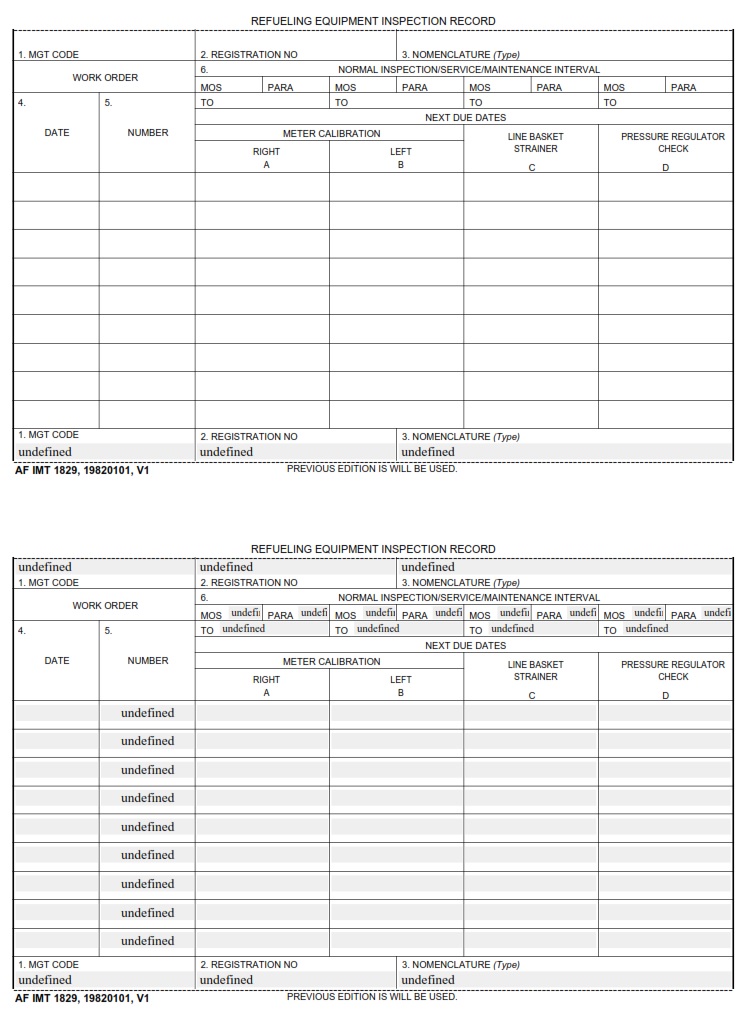AF-FORMS.COM – AF Form 1829 – Refueling Equipment Inspection Record – Imagine a world where aircraft soar through the skies, their engines roaring with power as they traverse great distances. In this high-stakes environment, ensuring the safe and efficient refueling of these aerial giants becomes paramount. Enter AF Form 1829 – the unsung hero of every successful refueling operation. This seemingly mundane document holds the key to meticulously recording and tracking the inspection of critical refueling equipment, ensuring that each component is in optimal condition for every mission. Join us as we delve into the world of aviation maintenance and explore how this seemingly simple form plays a crucial role in keeping our skies safe and secure.
Download AF Form 1829 – Refueling Equipment Inspection Record
| Form Number | AF Form 1829 |
| Form Title | Refueling Equipment Inspection Record |
| Edition Date | 1/1/1982 |
| File Size | 47 KB |
AF-Form-1829-Refueling-Equipment-Inspection-Record.pdf (23 downloads )
What is an AF Form 1829?
The AF Form 1829, also known as the Refueling Equipment Inspection Record, serves as a crucial document in the aerospace industry for monitoring and documenting the condition of refueling equipment. This form is used by aviation personnel to record detailed information about inspections conducted on refueling vehicles, hoses, nozzles, pumps, and other essential components. By meticulously documenting these inspections on the AF Form 1829, maintenance crews can ensure that all refueling equipment is safe to use and in compliance with regulations.
Furthermore, the AF Form 1829 plays a significant role in promoting safety within airbases and aviation operations. Regular inspections logged on this form help flag any issues with the refueling equipment before they escalate into potential safety hazards. By adhering to strict inspection protocols outlined in this form, airbase personnel can maintain high standards of safety and efficiency during refueling operations. Overall, the meticulous recording of inspections on the AF Form 1829 underscores not only attention to detail but also a commitment to ensuring safe and efficient refueling processes within military and commercial aviation settings.
Where Can I Find an AF Form 1829?
When it comes to locating an AF Form 1829 for refueling equipment inspection, the most reliable source would be the official Air Force website. This platform offers a variety of forms and documents readily available for download in a user-friendly format. Additionally, military supply offices or administrative departments within Air Force bases can provide physical copies of the form upon request.
For those seeking quicker access, utilizing online resources such as document repositories or specialized websites can also yield positive results. Websites that cater to military forms and documentation often feature a diverse collection of forms including the AF Form 1829, making it convenient for personnel to obtain the necessary paperwork promptly. Taking advantage of digital platforms can streamline the process and ensure easy accessibility to essential documents like the AF Form 1829 when required during refueling equipment inspections.
AF Form 1829 – Refueling Equipment Inspection Record
The AF Form 1829, also known as the Refueling Equipment Inspection Record, plays a crucial role in ensuring the safety and efficiency of refueling operations in the military. This form meticulously documents inspections of equipment such as hoses, nozzles, and valves to prevent leaks or malfunctions that could lead to hazardous situations on the airfield. Each entry on this form represents a commitment to precision and professionalism, highlighting the dedication of personnel responsible for maintaining refueling equipment at optimal performance levels.
Beyond its practical function, the AF Form 1829 symbolizes a culture of accountability within the military, where meticulous record-keeping is essential for operational success. By meticulously documenting every inspection and maintenance task performed on refueling equipment, personnel not only adhere to strict protocols but also contribute to a collective ethos of excellence in safeguarding against potential risks and ensuring operational readiness. The attention to detail reflected in each entry on this form underscores how even seemingly mundane tasks like routine inspections are vital components of maintaining high standards in military operations.
